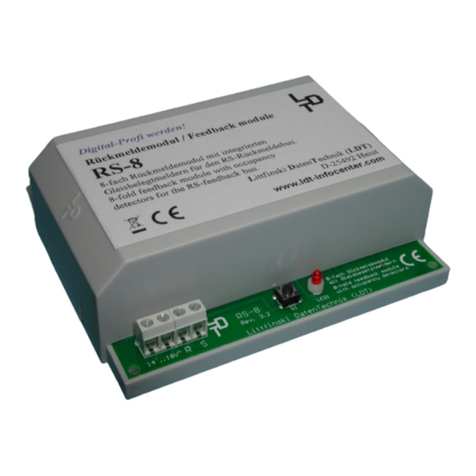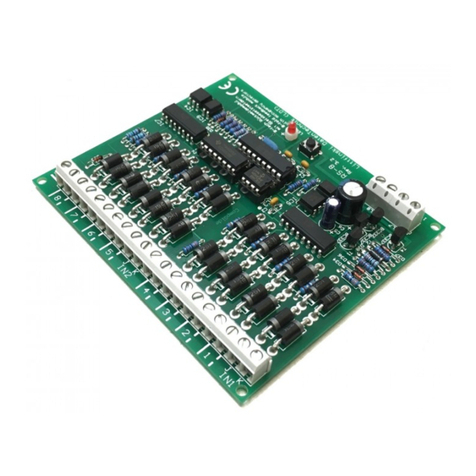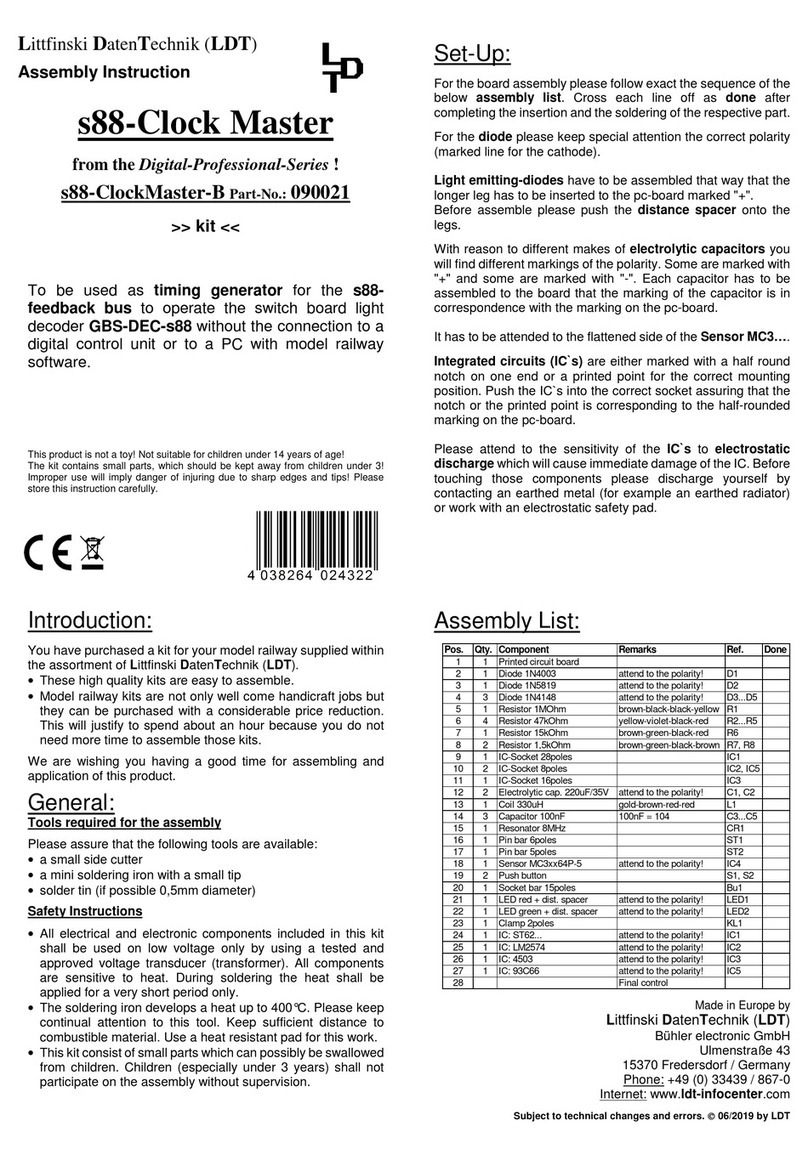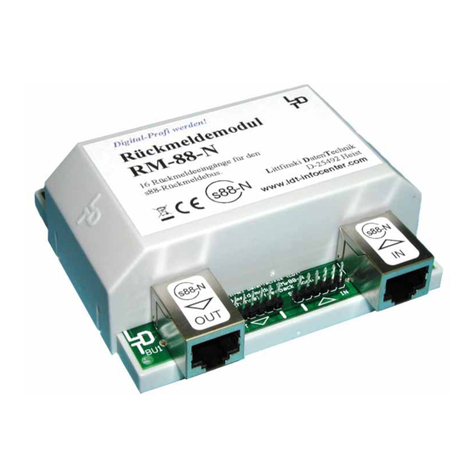
Soldering instruction
Provided you have no special experience in soldering electronic
components please read first this soldering instruction before starting the
job. Soldering has to be trained!
1. Never use additional fluxes for soldering electronic circuits which
contain acids (e.g. zinc chloride or ammonium chloride). Those can
destroy components and printed circuits when not washed off
completely.
2. As soldering material only lead free soldering tin with a rosin core for
fluxing should be used.
3. Use a small soldering iron with max 30 Watt heating power. The
solder tip shall be free from scale to assure an excellent heat transfer
to the area to be soldered.
4. The soldering shall be performed on a speedy way because a long
heat transfer can destroy the components. To much or to long
heating can take off the copper pads and copper tracks from the
board.
5. For a good soldering a well tinned solder-tip has to be brought in
contact to the copper-pad and the component wire at the same time.
Simultaneous a little solder-tin shall be applied for heating up. As
soon as the solder-tin starts melting the tin wire has to be taken away.
Just wait until the tin has well wetted the pad and the wire and take
the soldering iron away from the soldering area.
6. Make sure not to move the just soldered component for about 5
seconds after removing the soldering iron. This should create a silver
shining faultless soldering joint.
7. For a faultless soldering joint and well done soldering is a clean non-
oxidized soldering-tip absolutely required. It is not possible to perform
a sufficient soldering joint with a dirty soldering tip. Therefore please
clean the soldering tip from excessive solder-tin and dirt by using a
wet sponge or a silicone cleaning pad after each soldering process.
8. After completion of the soldering all connection wires have to be
cutted off directly above the soldering joint by using a side cutter.
9. By soldering semiconductors (transistors, diodes), LED`s and IC`s is
it very important never to exceed the soldering time of 5 seconds to
prevent the destruction of the component. It is absolutely required to
attend to the correct polarity of the component before starting the
soldering process.
10. After the board assembly carefully control the pc-board about correct
insertion of the components and the correct polarity. Please check if
no connections or copper tracks are accidentally short circuited by
soldering tin. This can not only result to malfunction of the module
but also result to a destruction of expensive components.
11. Please take into account that improper soldering joints, wrong
connections, faulty operation or wrong board assembly is not a
matter within our sphere of influence.
General installation information
The contact-wires of resistors and diodes to be assembled in a lying
position shall be bended in accordance to the raster distance into a right
angular position and assembled into the specified bores (in accordance
to the board assembly plan or the assembly markings). To prevent that
the components will not fall out by turn-over the pc-board please bend
the connection wires about 45° apart and solder them carefully to the
copper pads on the rear side of the board. Finally the excessive wires
shall be cutted off with a small side cutter.
The resistors in the supplied kits are metal-foil resistors. Those have a
tolerance of 1% and are marked with a brown “tolerance-ring”. The
tolerance ring can be identified by the larger margin distance respectively
the larger distance to the other four marking rings. Normally there are five
color rings on the metal-foil resistors. To read the color code you have to
locate the resistor that way that the brown tolerance ring will be on the
right side. The color rings will be red now from left to right!
Please take care to assemble diodes with the correct polarity (position of
the cathode marking). Take care about a very short soldering time! The
same will apply to the transistors and the integrated circuits (IC`s). The
flat side of the transistors has to correspond with the marking on the pc-
board.
The transistor legs should never be assembled in a crossed position.
Further those components should have a distance of about 5mm to the
board. Attend to the short soldering time to prevent the damage of the
component by excessive heat.
Capacitors shall be assembled into the respective marked bores, the
wires to be bent a little apart and careful soldered to the copper pad. By
the assembly of electrolytic capacitors (electrolytic cap) it has to be
attended to the correct polarity (+,-)! Wrong-way soldered electrolytic
capacitors can explode during the application! Therefore is it very
important to check the correct polarity two- or even better three-times. In
addition it has to be attended to the correct capacitor values, e.g. n10 =
100pF (not 10nF!).
A careful and clean assembly will drastically reduce the possibility that
anything will not be in correct function. Check every step and every
soldering joint two times before carrying on! Attend closely to the
assembly list! Perform the described step not different and do not skip
any step! Mark each step as done at the foreseen column after assembly
and careful check.
Take your time. Private work is no piece-work because the time for
careful assembly work is much less than an extensive fault diagnosis.
Final assembly
Sockets and integrated circuits (IC´s) of the kits will be supplied on a
piece of foam to assure safe transport.
This foam shall never be used below or between components as this
foam is electrical conductive.
In case the kit will be taken into operation the conductive foam can
produce a short circuitry and destroy the complete kit. Anyhow the
function of the module will not be as expected.
Warranty
As we have no influence to the proper and correct assembly we have to
limit our warranty to the complete supply and the faultless quality of the
components.
We guarantee the function of the components in accordance to the
identified values within a non-assembled condition of the parts and the
compliance of the technical data of the circuit by attending to the
respective soldering instruction and the specified start of operation of the
module including connection and operation.
Further demands are not accepted.
We are not taking over any warranty nor any liability for any harm or
sequential damage connected to this product.
We reserve our right for a repair, rework, supply of replacement or refund
of the purchase price.
The following criteria will result to a non-repair respectively to a lost of
right to claim under guarantee:
•if acid-containing soldering tin or fluxes with corrosive content and
others have been used
•if the kit has been improper soldered or assembled
•by alterations or repair-trials on the device
•by own circuit amendments
•by construction of non-intended improper displacement of
components, free wiring of components etc.
•application of other non-original kit-components
•by damaging of copper tracks or soldering copper pads on the board
•by wrong assembly and the sub sequential damages
•overloading the module
•by damages caused by intervention of foreign persons
•by damages caused by disregarding the operation manual
respectively the connection plan
•by connecting a wrong voltage respectively a wrong current
•by wrong polarity connection of the module
•by wrong operation or damages caused by negligent usage or abuse
•by defects caused by bridged or wrong fuses.
All such cases will result to a return of the kit to your expenses.
Subject to technical changes and errors. 05/2013 by LDT
























